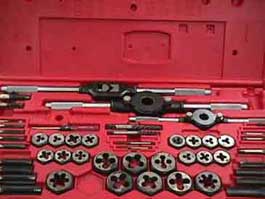|
Home
Taps and Dies
|

|
Taps and Dies are used to put threads either on
the inside of a hole or on the outside of a
rod.
This sheet describes the procedure for tapping a
hole and using a die to make threads by hand on a
part.
|
Controls: The controls when
using taps and dies are as follows.
- Correct tap or die selection
- Feeds and speeds
- Tool condition and surface condition
- Tap Wrenches which are used to hold the taps by the
square and to manually thread the part.
- Die Wrenches which are used to hold the dies by there
hexagonal shape and are used to manually thread the
part.
Note: Note when using taps and dies in machinery there
may be many more controls.
Operation: Tapping a hole
- Drill a hole
- Use tap/drill size chart to choose the correct the
right tap
- Use oil to lubricate while tapping.
- Put the tap into the tap wrench
- Insert the tap into the hole.
- Apply some pressure on the handle of the wrench.
- Slowly turn the tap in a clockwise
direction.
- Once tap begins cutting the metal and making threads
it will become hard to turn the tap. Back the tap off 1/4
turn or until you hear the metal chip break.
- Continue feeding the tap into the hole and after
every 1/2 turn back off 1/4 turn to break the metal chip.
Once all the way through back the tap out in a counter
clockwise direction until the tap is removed form the
hole.
- Once all the way out, the process if complete.
Operation: Using a die
- First you must chose the correct die for the size
diameter rod. Use a chart if necessary.
- Use oil to lubricate during cutting operation.
- Put the die into the die wrench
- put the die on the end of the rod that you want to
make threads on.
- Apply some pressure to the handle of the wrench.
- Begin turning the wrench in a clockwise
direction.
- Once the die begins cutting the metal and make
threads it will become hard to turn.
- Use the same process as the tap to break the metal
away from the die.
- Thread the rod as far as needed then back the die all
the way off, by turning the wrench in a counter clockwise
direction.
Note: There are several other operations that can be done
using taps and dies. This is just for basic
operations.
Trouble shooting: Some
helpful hints when using taps and dies.
- Taps-
Breakage:
Incorrect Tap Selection
Excessive Tapping Torque
Operating Conditions
Tool Conditions
Chipping:
Incorrect Tap Selection
Operating Conditions
Wear:
Incorrect Tap Selection
Operating Conditions
Tool Conditions
Undersize Pitch Diameter:
Incorrect Tap
Damaged Threads
Torn or Rough Threads:
Chamfer Too Short
Wrong Chamfer Angle
Galling
Chip Packing
Dies-
The same applies for dies, correct selection and tool
condition is essential to good operation.
Safety practices: Because
of potential hazards the following safety rules must be
followed:
- Always wear safety glasses when doing an
operation.
- Pinching could occur if skin got between the tap or
die during an operation.
- Taps and Dies are very sharp so use care when
handling them so that you don't cut yourself.
Note: Many more safety practices would have to be taken
if using taps and dies mechanically. Since we are using them
manually by hand there is little hazard.
References:
Graham, Gregory S. (1981). Metalworking: An
Introduction. American Technical Publishers, Inc. Alsip,
IL.
http://www.regalcuttingtools.com
.
ITT 252 - Materials Processing
Department of Technology
University of Southern Maine
Prepared by Robert Owens, 12-12-02
|
